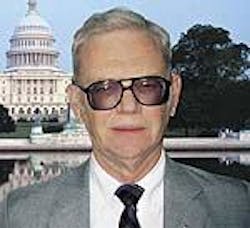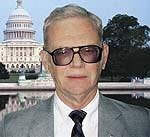Homeland security: form vs. function
John Rhea
This will not be a simple task. In fact, it will be the largest federal government reorganization since the creation of the Defense Department in 1947.
WASHINGTON — The noted Chicago architect Louis Sullivan, senior partner of Frank Lloyd Wright, is probably best known for his proclamation, "Form ever follows function." The idea seems to work for architecture; it ought to work elsewhere.
In the case of homeland security, the function has been obvious since the morning of last Sept. 11: pull together the various capabilities scattered throughout the federal government in order to apply readily available technology to the problem of repulsing terrorists.
Form is another matter. Despite substantial nationwide momentum to do something now about the problem, nearly a year later it is still not clear what kind of Department of Homeland Security is to be established and who will be in it. Further delays risk eroding that momentum.
What goes on inside the Washington Beltway is of considerable interest to the high-technology industries, whose expertise and products will be essential to the effort. These industries have long-standing contractual and other relationships with the various agencies proposed for inclusion in the new Department of Homeland Security (DHS). How DHS is put together will determine the future of those relationships.
The Bush Administration has proposed pulling together a workforce of 169,000 full-time employees from 22 different agencies under Homeland Security Director Tom Ridge. This amounts to more than 100 bureaus, branches, sub-agencies, and sections, all with their own distinctive cultures. DHS would have an annual budget of $38 billion, about one-tenth of what the Defense Department will spend next year.
This will not be a simple task. In fact, it will be the largest federal government reorganization since the creation of the Defense Department in 1947 — and that involved combining military services that had many similar and overlapping functions.
There is also the problem of relocating the DHS personnel in a central facility to create a climate of synergism. Nobody is talking about building another Pentagon, but if this reorganization is simply a matter of giving the employees new badges and leaving them in their old offices it raises the question of why is it being done at all. The General Services Administration, which is the landlord of record for all federal agencies, will have to tackle the details of that job.
Just as the job isn't going to be done quickly, it isn't going to be done cheaply either. The Congressional Budget Office estimates that startup costs alone will run $3 billion between fiscal years 2003 and 2007.
The original Bush proposal, which has begun encountering resistance in Congress, called for the bulk of the DHS employees (145,000) to come from just four agencies, all of them with markedly different missions: the Coast Guard (more than 43,000), the Transportation Security Agency (41,300), Immigration and Naturalization Service (39,400), and Customs Service (21,700).
Where the going gets tough is with the agencies that powerful members of Congress don't want to see transferred to DHS. At the top of this list is the Federal Emergency Management Agency (FEMA), which has a number of other vital domestic functions. House members have also opposed transferring the Secret Service to the new department, recommending instead that it be put into the Justice Department.
Other contentious issues include the Immigration and Naturalization Service, which President Bush wants to transfer intact to DHS, and the Coast Guard, which has its own powerful constituency on Capitol Hill. There has also been opposition to transferring the intelligence functions of the Department of Energy's Lawrence Livermore National Laboratory of Livermore, Calif., which specializes in chemical, biological, and radiological issues.
Everybody seems to mean well, but platitudes aren't going to get the job done. For example, Treasury Secretary Paul O'Neill testified last month before the House Select Committee on Homeland Security that "simply collecting the organizations that have been named under one new title is not what we need to do.
"We need to deploy the resources that are going to be made available in a way that's consistent with a mission that needs to be performed," O'Neill said, "not simply a continuation of the missions as they have been performed in the past."
Joining O'Neill was Secretary of State Colin Powell, Attorney General John Ashcroft, and Defense Secretary Donald Rumsfeld in supporting the President's plan. They all said pretty much the same thing.
Agreed, but how about a concrete, workable plan? Maybe there's a better way to achieve the same function without all the current agonizing over the form.
Experts in the Washington-based Brookings Institution say they think so and have issued their own report asserting that the President's proposal "merges too many different activities in a single department" and should be scaled back if it is to have any chance of success.
"The danger is that top managers will be preoccupied for months, if not years, with getting the reorganization right — thus giving insufficient attention to their real job: taking concrete action to counter the terrorist threat at home," the think tank reported.
The Brookings study recommended that the White House plan be stripped down to focus on border and transportation security, intelligence analysis, and protection for the nation's critical infrastructure. It also opposed transferring FEMA to DHS, but agreed with the President on transferring the four principal agencies.
Norman Ornstein, a resident scholar at another Washington think tank, the American Enterprise Institute, raises the parallel question of how this government-wide shakeup will impact employee morale. Such mundane considerations as carpooling arrangements are not mundane to those who are affected, he says.
"Any careful student of government — and any observer of human behavior — knows that the transition and first year of operation will be rocky, maybe the rockiest in the history of the Republic," Ornstein told the Washington Post.
I wonder why a new department is necessary at all. The White House-level National Security Council has managed quite effectively in my view to coordinate the Departments of Defense and State and the other federal agencies in matters of national defense. Why not a White House-level Domestic Security Council — plus better lines of communications with the operating agencies — to accomplish the same thing in repelling terrorists without uprooting the people involved?
Don't look for any overnight solutions. While the original goal was to have a new department open for business by the Sept. 11 first anniversary of the attack, Congress is taking its traditional summer vacation this month and will have plenty of other business before it when it returns.
I think it would be useful for the lawmakers to use some of that vacation time to reflect on how they can create the best form to deal with the universally agreed upon function.

